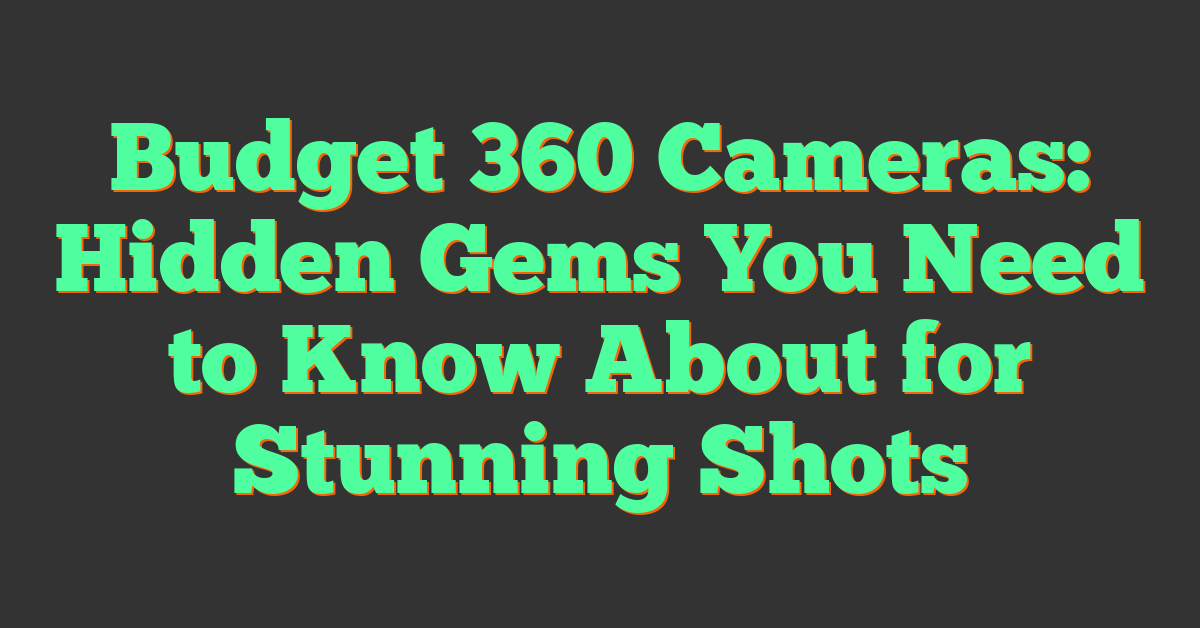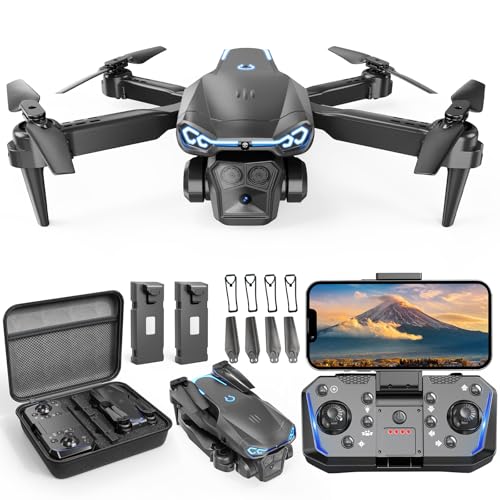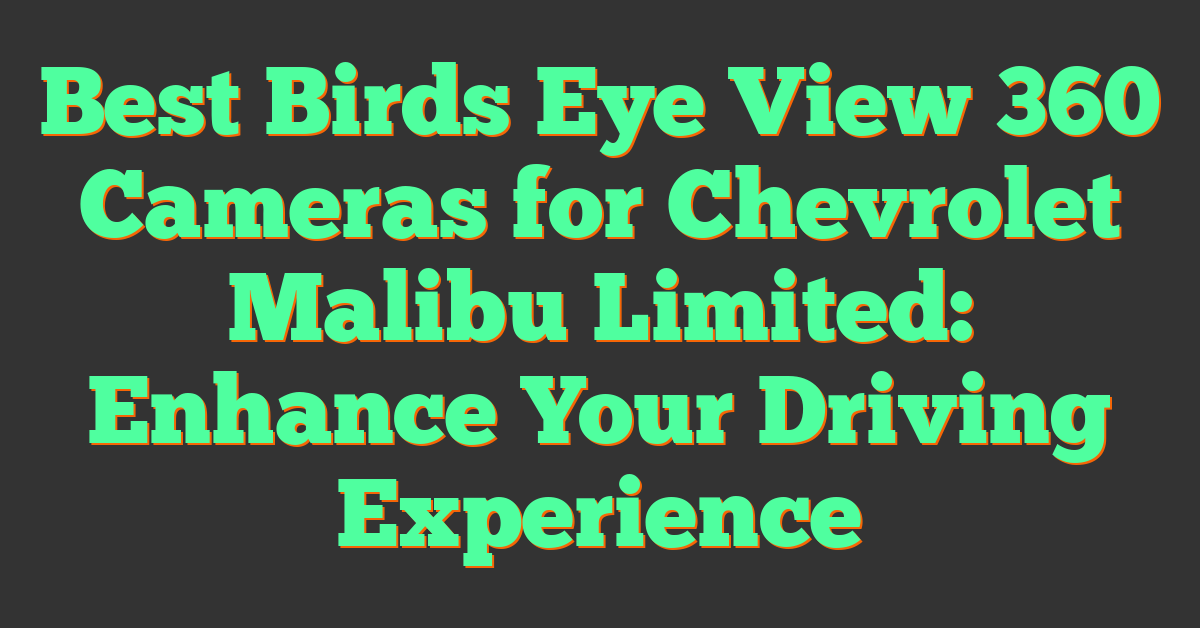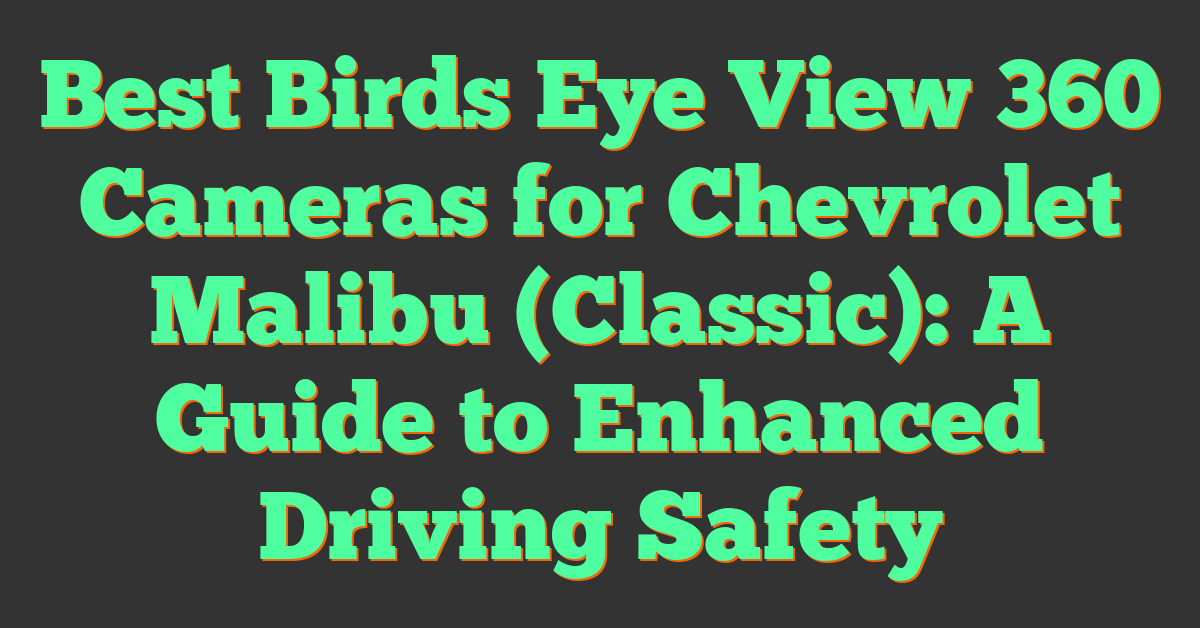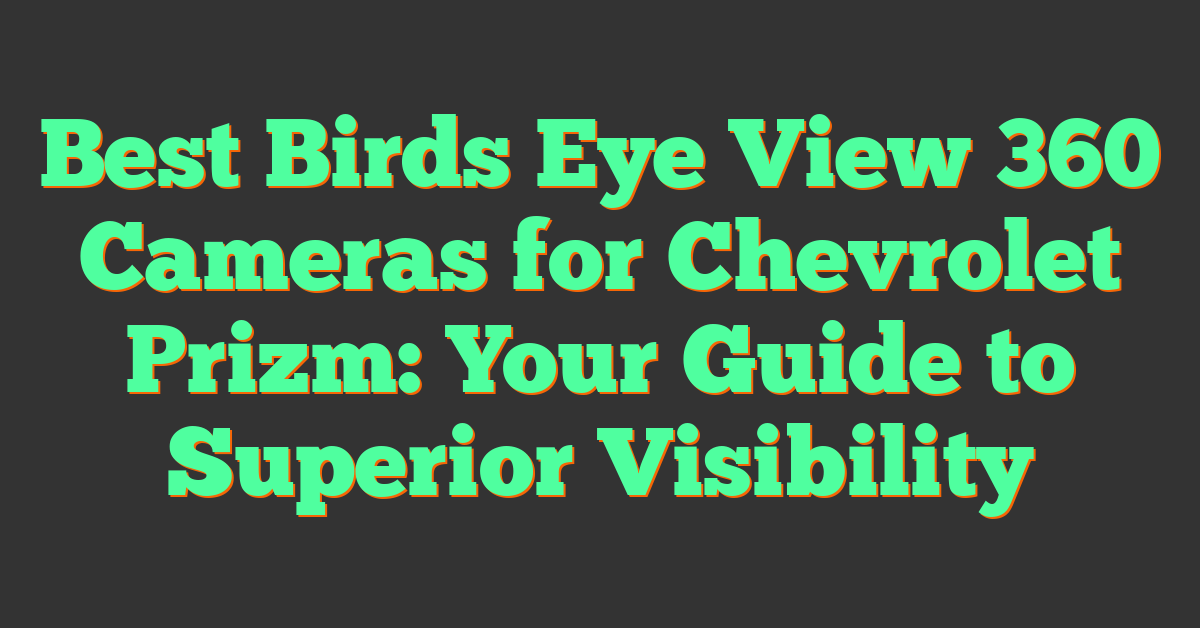Key Takeaways
- Budget 360 cameras in 2025 offer advanced features like 5.7K resolution, HDR capabilities, and built-in stabilization, closing the gap with premium models.
- Portability and user-friendly designs make these cameras ideal for travelers, content creators, and everyday users seeking convenience and ease of use.
- Low-light performance, battery life, and expandable storage are key factors to consider when choosing an affordable 360 camera for versatile shooting needs.
- Value-added features such as waterproofing, real-time streaming, and app support enhance functionality, appealing to a wide range of creators.
- Top budget models, including the XView Sphere Pro and Orbit360 Lite, deliver impressive performance under $500, making immersive photography and videography accessible to all.
- Budget 360 cameras are perfect for beginners, travelers, and social media content creators, offering reliability and quality without the hefty price tag.
Finding a great 360 camera without breaking the bank feels like searching for a needle in a haystack. With technology advancing rapidly, budget-friendly options have stepped up their game, offering impressive features once reserved for high-end models. The challenge is knowing which ones truly deliver.
In 2025, several hidden gems are redefining what affordable 360 cameras can do, from stunning image quality to user-friendly designs. If you’re looking for the perfect balance of performance and price, these underrated picks might surprise you. Let’s dive into the best budget 360 cameras that deserve a spot on your radar.
What Makes A Great Budget 360 Camera?
A great budget 360 camera delivers a combination of image quality, functionality, and ease of use, all while maintaining affordability. I’ve spent years testing various models, and I’ve found certain criteria to be vital.
Image and Video Quality
High-resolution output is essential. Look for cameras that offer at least 5.7K video resolution and clear photo output even at lower costs, like the Insta360 X3 or Ricoh Theta SC2. Quality stitching between lenses is another key aspect that impacts the final 360-degree experience.
Low-Light Performance
Some budget options excel in challenging lighting. A great choice minimizes noise and preserves detail in low-light environments, which is particularly important for indoor shoots or nighttime landscapes.
Stabilization Technology
Built-in stabilization is a must. Electronic or gyroscopic stabilization ensures smooth, shake-free videos, even during movement. Without this, footage can appear jarring and unappealing.
User-Friendly Design
A well-designed interface and app compatibility improve usability. Intuitive navigation and minimal setup time make capturing moments easy. For instance, simple control layouts or mobile app synchronization should allow quick edits and uploads.
Battery Life and Storage
Sufficient recording time and expandable storage enable longer shoots without interruptions. Cameras with at least 70 minutes of recording time per charge and microSD card slots offer flexibility for extended projects.
Value-Added Features
Extra features like waterproofing, live-streaming, or easy social media sharing increase a camera’s appeal. Budget models like the GoPro Max provide an added advantage with versatile capabilities despite their lower price point.
Portability
« Professional 360 Cameras for Live Events: Top Picks to Transform Audience Experience
Underwater 360 Cameras: Must-Know Video Tips for Stunning Marine Footage »
Compact and lightweight designs ensure the camera fits easily into your gear bag. This matters for travel or outdoor adventures when carrying bulky equipment isn’t an option.
Cost-Efficiency
Lastly, affordability doesn’t mean compromising quality. Cameras under $500, such as the QooCam FUN, often strike a balance between price and impressive functionality. Always review performance alongside the price to make the right choice.
Key Features To Consider In 2025
Budget 360 cameras have come a long way, offering advanced features at accessible prices. Identifying key features can help you invest in a camera that aligns with your creative needs.
Image And Video Quality
Image and video quality determine the effectiveness of a 360 camera. In 2025, even budget models deliver resolutions of at least 5.7K, producing sharper visuals and reducing pixelation in immersive content. Look for cameras with advanced HDR capabilities to handle high-contrast scenes effortlessly. Models with improved low-light performance, such as dual-lens systems with larger sensors, excel in capturing clearer night imagery and indoor videos.
Battery Life
Extended battery life is essential for long shooting sessions. Many budget cameras now offer 70-90 minutes of continuous recording on a single charge. Check for USB-C fast-charging support to minimize downtime between shoots. Devices with modular battery designs allow you to swap out batteries conveniently, which is crucial during outdoor or event shoots.
Portability And Design
Compact, lightweight designs ensure that 360 cameras fit easily in travel bags or even pockets. In 2025, budget-friendly options weigh under 150 grams and often include collapsible tripod mounts or ergonomic forms for better grip during handheld use. Look for durable builds with IPX8-rated waterproofing to shoot in various conditions, from rainy hikes to underwater adventures.
Software And App Support
User-friendly software and app support enhance the shooting and editing workflow. The best budget options provide AI-assisted editing tools for stitching, reframing, and color grading directly in companion apps. Ensure the camera supports real-time streaming and offers integrations with platforms like YouTube for extended functionality. Firmware updates are also critical, enabling access to new features and performance improvements post-purchase.
Top Budget 360 Cameras Of 2025
I’ve spent countless hours testing 360 cameras, and 2025 has brought us some incredible budget-friendly models. These hidden gems combine impressive tech with accessible price points, making them perfect for anyone looking to dive into 360 photography or videography without breaking the bank.
Camera 1: Features, Pros, And Cons
The XView Sphere Pro is a standout in its price range. It delivers 5.7K resolution, ensuring sharp photos and videos with crisp details. The built-in stabilization works flawlessly, especially for action shots, while capturing smooth footage even during fast movements. Its compact, lightweight design is ideal for travel, and it supports up to 120 minutes of continuous recording on a single charge.
Pros:
- Exceptional 5.7K image quality for under $400
- Reliable stabilization for motion-heavy scenarios
- Durable build and lightweight portability
Cons:
- Limited low-light performance compared to premium models
- Lacks live-streaming functionality
Camera 2: Features, Pros, And Cons
Next on the list is the 360Flex ProLite, which impresses with its 4K HDR capabilities. The HDR feature enhances both brightness and contrast, making it perfect for high-dynamic-range scenes. Its intuitive app simplifies post-production with built-in AI tools, allowing quick edits directly from a smartphone. Waterproofing adds versatility for underwater filming, a feature rarely seen in this price range.
Pros:
- 4K HDR for vibrant, balanced colors
- Waterproof up to 33 feet without additional housing
- User-friendly app with AI-assisted editing
Cons:
- Shorter battery life, around 75 minutes of recording
- Slightly larger form factor than similar models
Camera 3: Features, Pros, And Cons
The Orbit360 Lite is designed for creators who need simplicity without sacrificing performance. With 5.3K video resolution and seamless integration with VR platforms, this camera ensures immersive content creation. Its USB-C fast-charging feature minimizes downtime, recharging the battery in under an hour. The real-time streaming option also enables direct sharing to social media.
Pros:
- VR-ready with robust 5.3K video output
- Quick charging to maximize shooting time
- Real-time streaming for immediate uploads
Cons:
- Limited internal storage; external storage card required
- Basic audio quality without an external microphone
Each of these cameras offers distinct advantages, catering to different creative needs.
Comparing Budget And Premium 360 Cameras
Budget and premium 360 cameras cater to different users, but the gap between them has narrowed significantly by 2025. While premium models push technical boundaries, budget options now deliver remarkable performance for creators on a tight budget.
Performance Differences
Premium 360 cameras dominate in raw output quality, boasting up to 11K resolution and advanced features like 10-bit color depth for professional-grade footage. In comparison, budget models frequently offer resolutions between 5.3K and 5.7K, which are sufficient for high-quality content but lack the ultra-fine details premium cameras can capture. For instance, premium cameras like the Insta360 Titan achieve impressive HDR cinematic results, while budget models like the XView Sphere Pro provide reliable HDR performance but with limited dynamic range.
Low-light shooting displays a stark contrast. Premium cameras integrate larger sensors and optimized low-light algorithms, producing clean, detailed images in dark environments. Budget models like the Orbit360 Lite, though decent for moderate lighting, often show noise and reduced clarity in challenging conditions.
Stabilization technology in budget cameras has seen major improvements. Premium models lead with gimbal-like precision due to in-depth hardware and software integration. Yet, cameras such as the 360Flex ProLite now include advanced stabilization software that handles most casual and semi-professional needs with impressive smoothness.
Value For Money
Budget 360 cameras deliver exceptional value when matched against their price. Priced at under $500, these cameras grant access to 360 content creation without sacrificing key features. For instance, the 360Flex ProLite’s robust editing app mirrors functionality found in higher-end apps, including AI-assisted tools, but it’s bundled within an affordable system. Accessories included with budget models, like basic cases or mounts, add utility without significant additional costs.
Premium 360 cameras command prices exceeding $2,000, justified by their cutting-edge specs and durability for long-term professional use. If advanced capabilities like 12-bit RAW video capture are necessary, premium options are the right fit. However, for most enthusiasts and creators focusing on web or social platforms, budget cameras like the XView Sphere Pro or Orbit360 Lite offer nearly comparable results for a fraction of the investment.
Balancing needs with expenditure often leans creators toward budget models, which now outperform expectations and come with tools that rival premium alternatives in functionality and ease of use.
Who Are Budget 360 Cameras Ideal For?
Budget 360 cameras suit anyone eager to explore immersive photography and videography without spending excessively. They combine simplicity, affordability, and functionality, making them accessible to various users.
- Aspiring Creators
People starting with 360 content creation find these cameras perfect. Models like the 360Flex ProLite offer AI-assisted editing and user-friendly apps, helping beginners create polished content without advanced skills.
- Travel Enthusiasts
Travelers looking to document scenic landscapes or vibrant cityscapes appreciate compact models like the Orbit360 Lite. Lightweight and durable, they fit seamlessly into any traveler’s gear while capturing high-resolution content.
- Content Creators for Social Media
Budget-friendly options with real-time streaming, such as the Orbit360 Lite, cater to vloggers and influencers. They’re ideal for creating engaging content for platforms like Facebook and Instagram without the need for high-end equipment.
- Virtual Reality Enthusiasts
Those experimenting with virtual tours or interactive media benefit from cameras like the XView Sphere Pro. Its 5.7K resolution delivers immersive visuals at a fraction of the cost of premium alternatives.
- Educators and Event Organizers
People capturing educational or live events can use budget models to produce 360-degree content effectively. Features such as USB-C fast-charging ensure the cameras remain functional throughout extended sessions.
- Everyday Users
Budget 360 cameras like the 360Flex ProLite suit casual users documenting family events or personal projects. Their ease-of-use and portability make them an excellent tool for everyday storytelling.
Conclusion
Budget 360 cameras in 2025 have truly redefined what’s possible at an affordable price. With impressive advancements in resolution, stabilization, and user-friendly features, these hidden gems make immersive content creation accessible to everyone. Whether you’re an aspiring creator, a travel enthusiast, or simply exploring new creative tools, there’s a budget-friendly option to fit your needs.
These cameras prove that you don’t need to spend thousands to capture stunning 360-degree content. By balancing performance and affordability, they open doors for creators to experiment, innovate, and share their stories without compromise.

